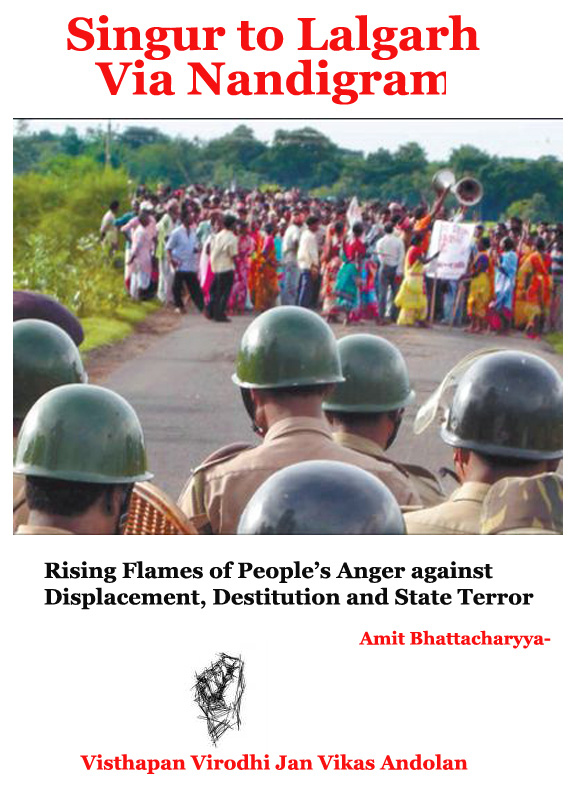Cops doubt, rebels ready – Sparse deployment in Maoist zones adds to trouble
Posted by Admin on September 12, 2009
 SANKARSHAN THAKUR
SANKARSHAN THAKUR
Security personnel during the Lalgarh offensive
New Delhi, Sept. 11: The Centre’s impending anti-naxalite offensive appears to have an inverted preface — the Maoists, as targets, appear ebullient over taking on the challenge, as their June document suggests; the security forces are riddled with doubt and pessimism. “It’s one thing for a powerful state to declare intent to wipe out a security threat, quite another to carry it out,” said a top police officer, who has had a decade’s experience of fighting armed Naxalites in Bastar, “the fact remains that despite everything, we have not achieved ascendancy over Naxalites, on the contrary, they have expanded.”
One of the concerns top police officials from several Naxalite-affected states have been raising is the fundamental issue of poor manning and deployment, a key factor in prompting a frustrated counter-terror specialist K.P.S. Gill to give up his counter-Naxalite foray in Chhattisgarh three years ago.
Just to use a standard yardstick, the prescribed UN norm for minimum police strength in security-sensitive areas is about 222 per 100,000 people. Most Western countries have ratios in the region of 250 to 500 per 100,000. Some Indian States also have very high ratios — Mizoram, for instance has 854 security personnel per 100,000 population, Sikkim has 609 per 100,000. By contrast, some of the Naxalism-affected states fall way behind: Chhattisgarh has a 103 per 100,000 presence, Orissa 99, Andhra and Jharkhand 98, Bengal 94 and Bihar a mere 57.
This crisis is often compounded by an endemic gap between sanctioned strength and the force available, which varies between 20 per cent and over 50 per cent at various ranks, and even more in the Maoist-affected areas, where the deficit at certain ranks may be as high as 79 per cent. In Orissa, where Maoists have proliferated fastest over the last decade, there are currently only 97 serving IPS officers as opposed to a sanctioned strength of 207. The state wanted eight IPS officers from the last batch that passed out; it got only four.
To make matters even worse, there has been no recruitment of mid-level police officers because examinations for picking them have not been held in Orissa since 1976. “This is an abysmal state of affairs,” one officer complained, “because Orissa has almost forgotten about directly-recruited DSP level officers, only one policeman qualified for being promoted to the IPS, the remaining 47 posts for promotees are going a begging.”
Another officer pointed to similar deficiencies and mismanagement in Chhattisgarh, saying the majority of those trained at a specialised anti-Naxalite operations facility in Kanker in Bastar were not even deployed in areas they were trained for. “Close to 5,000 boys have come out of the Kanker school, but only 800 of them are in counter-Naxalite operations, the rest are probably securing VVIP politicians in Raipur. Are we even serious about using our personnel purposefully?”
The Union home ministry has recently unrolled plans to raise a minimum of 25 new battalions in Naxalite-affected states — this would mean an addition of a little more than 30,000 combat hands — but the process will take at least a year and officials reckon the added numbers may not be sufficient.
Stressing that the chief job in anti-Naxalite operations will have to be done by respective state police, he said these forces were “alarmingly deficient” in both personnel and material terms. A model, he suggested, was Andhra Pradesh, where for the last decade or so, all police personnel from assistant sub-inspector up to the superintendent of police level have to mandatorily undergo two years of specialised on-ground anti-Naxalite training.
“At least you have a mentally-prepared cadre in Andhra Pradesh and the results are there to see,” the officer said. “Other states need urgently to follow that example, because if the local police are not good, no amount of specialised paramilitary or army units can help because they will have nothing to go on”.
A classic case of this, he pointed out, was the massacre of nearly an entire Greyhound unit in Malkangiri in Orissa last year — “These were crack troops, but they had no local intelligence the Naxalites were lurking around, they became sitting ducks.” TT

























Leave a comment